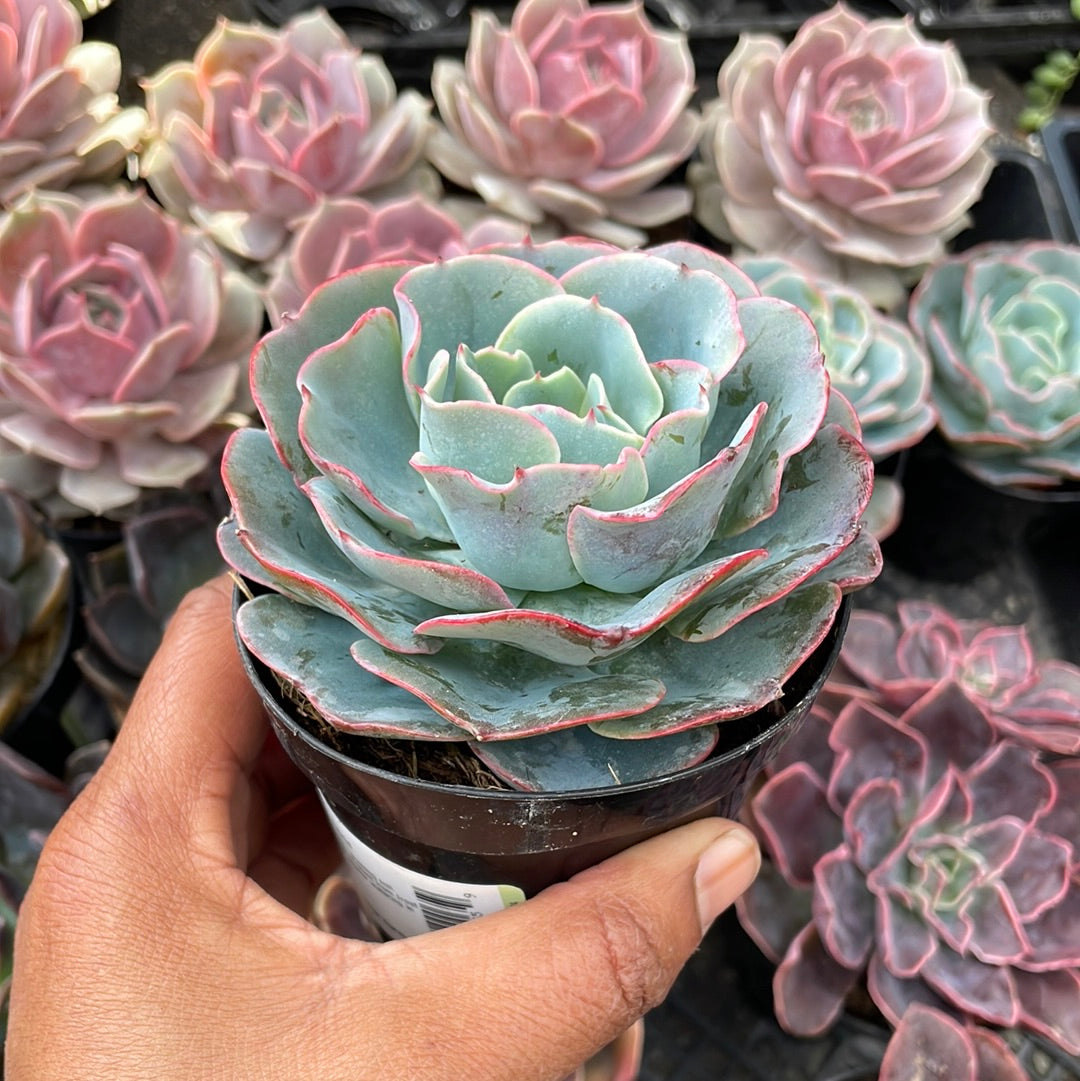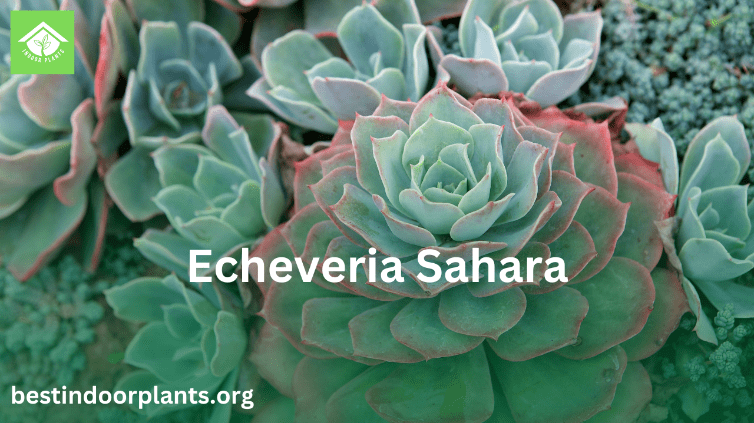Echeveria Sahara is a stunning succulent admired for its rosette shape and striking color palette but this plant has become a favorite among succulent enthusiasts because it is a hardy plant with fleshy leaves and vibrant hues. Propagating Echeveria Sahara can be rewarding whether you want to increase your collection or simply share the love of succulents with others. This detailed guide will walk you through Echeveria Sahara propagation methods, care tips, and common issues that may hinder successful growth of these healthy and beautiful succulents.
Introduction to Echeveria Sahara
This plants beauty goes beyond just looks; it is also highly resilient but relatively easy to look after. For those who are starting out on gardening or experts in growing other types of succulents, Echeveria Sahara reckons an easier yet satisfying process of propagation.

Echeveria Sahara is a popular succulent known for its unique rosette form and varying colors that encompass greens, pinks, and reds. It’s compact growth makes it ideal for container gardening, terrariums as well as decorative arrangements. This plant originates from arid regions hence it can do well in dry conditions unlike others which requires minimal water for them to flourish.
Attractive Benefits of Propagating Echeveria Sahara
Gardening on a Budget
Cost Saving: Growing your own Echeveria Sahara saves you some money as you don’t have to buy new plants when expanding your collection or designing unique arrangements.
Individual Satisfaction
Skills Development: Be involved in plant care and propagation techniques. It will bring self-fulfillment if new plants grow successfully.
Expanded Plant Collection
Diversity and Personalization: Widen your succulents portfolio by obtaining various kinds of Echeveria Sahara for planting in personal pots.
Advantages for the Environment
Eco-friendly Approach: This aids in reducing waste significantly thereby promoting environmental conservation. It also ensures that less need arises for purchasing the fresh crop from nurseries.
Learning Opportunities
Educational Experience: Teach other people about how to care for plants while broadening one’s knowledge about horticulture through reproduction.
Health and Wellness
Therapeutic Effectiveness: Gardening is known to reduce anxiety and enhance mental condition as well. Moreover, it helps clean indoor air from toxins, etc.
Cultural and Aesthetic Appeal
Beautifulness and Heritage: Take pleasure in creating nice looking plantings just like our ancestors did with their cultural traditions related to sharing plants.
Preparing for Propagation
Before you start propagating Echeveria Sahara, proper preparation is essential to ensure success. Follow these preparatory steps:
Select a Healthy Parent Plant
Choose a robust and healthy Echeveria Sahara for propagation. Avoid plants that show signs of disease or pest infestations, as these issues can be transferred to the new plants.
Gather Your Supplies:
- Clean, Sharp Tools: Use a clean, sharp knife or scissors for cutting leaves or offsets. Clean tools help prevent the spread of disease.
- Well-Draining Soil: Use a potting mix designed for succulents, which provides excellent drainage and prevents root rot.
Containers
Propagation Techniques for Echeveria Sahara
Echeveria Sahara, a variety of succulent species, can be easily propagated by leaf cuttings, offsets, and seeds. Every method has its advantages and different levels of experience it suits.
Leaf Cuttings
Leaf cuttings are some of the most basic ways to propagate succulents. This involves taking healthy leaves from the parent plant and encouraging root growth in them.
Steps for Leaf Cuttings:
- Choose a Healthy Leaf: Select a matured outer rosette leaf from the plant that is healthy. The leaf should be firm and unblemished.
- Remove the Leaf: Twist off the leaf gently from its stem ensuring complete detachment from any part of stalk still left on the plant.
- Let the Leaf Callous: Put this leaf on clean dry surface for 3-5 days. This prevents rotting by letting the cut end dry up and callous over before planting.
- Plant the Leaf: After callusing take this leaf and set it onto some well-drained succulent soil mix above ground level without burying it.
- Water Lightly: Keep watering or misting with small amounts every few days so that soil is slightly moist but not too wet as excess moisture would lead to rotting process.
- Wait for Roots: Roots will start to develop after a few weeks. Once leaves have developed a healthy root system they can be potted into larger containers.

Offsets
Offsets are also known as pups; they are small growths around base of parent plant which grow separately into new plants. It does more advanced than leaf cutting and tends to result faster outcomes in general instances.
Steps for Offsets:
- Identify and Remove Offsets: Look out for offsets around your parent plants bottom area; carefully break away using sterile knife or scissors ensuring it has roots attached to it.
- Let Offset Callous: Dry offset out then let callouse over period days before planting because this inhibits rotting.
- Plant Offset: Place offset in a small pot with a well-draining succulent soil mix. Lightly water the soil after planting.
- Offset Care: Treat it as you would an adult Echeveria Sahara, giving it the right amount of light and water.
Seeds
This is a slower method of propagation but can be fascinating for growing new Echeveria Sahara plants from scratch.
Steps for Seeds:
- Prepare Seed Tray: Use seed-starting mix meant for succulents to fill up seed tray or shallow pot.
- Sow Seeds: Ensure seeds are evenly sprinkle across the surface of the soil. Do not cover them with soil since they need light to germinate.
- Maintain Humidity: Every day, lightly mist superficial layer of the soil so that it remains moist. For purposes of maintaining humidity, use clear plastic wrap or lid to cover this tray.
- Provide Light: Select a bright place where you will put this tray away from direct sunlight heat which may scorch these seeds. Germination may take few weeks or several months.
Caring for Your Propagated Echeveria Sahara
Looking after your propagated Echeveria Sahara is crucial for its prosperity. Observe the following tips to ensure that it grows healthily:
Irrigation
Echeveria Sahara is a type of succulent that requires less water and therefore, needs only occasional watering. Over-watering can lead to root rot. Water it only when the soil has completely dried out. During periods of active growth (spring and summer), water every 1-2 weeks; reduce watering during winter that slows down plant growth.
Lighting
Echeveria Sahara grows well in bright indirect light. A south or west-facing window would be ideal. If natural lighting is not sufficient, consider using grow lights as supplements. The plant should not be placed under direct sunlight because this may cause sunburns and leaf damage.
Fertilizer
Use a balanced water soluble fertilizer made for use on succulents to feed your Echeveria Sahara regularly. Apply fertilizer once each month throughout the growing season (spring and summer). Excessive fertilization will result in overgrowth and poor general health of the plants.
Common Issues in Troubleshooting
Echeveria Sahara is a plant that can be problematic even if you have taken good care of it. Here are some common problems:
Leaves Drop or Rot:
The leaves drop or rot due to causes such as excessive watering, poor drainage or during propagation.
Solutions: Find out whether the soil is too wet and decrease the number of times you water it. The pot should be allowed to drain properly and the soil should dry completely. Take away any softening leaves before they spread.
Long Shoots:
The shoots get leggy with not enough light supply.
Solutions: Transfer the plant to a brighter place or provide additional lighting via a grow light source. It’s essential to rotate the plants regularly so that they can grow evenly.
Infestation by Pests:
Types of Pests: Mealybugs, spider mites, aphids are types of insect pests found on this type of cactus plant.
Solutions: Regularly inspect the succulents for insects. In case an infection occurs, apply soap insecticide, neem oil and mild soap mixed with water for spraying onto them continuously making sure that air circulates adequately around their leaves helping to prevent pest infestation along them.

FAQ: Propagating Echeveria Sahara
When is the optimum period to propagate Echeveria Sahara?
Answer: Ideally, one should propagate Echeveria Sahara in spring and summer months which are normally characterized by an active growth and thus there is a high likelihood of successful cuttings and offsets being produced.
From where do I propagate leaf cuttings for Echeveria Sahara?
Answer: For leaf cuttings, you twist off a healthy leaf from the stem gently and then give it time to callous for some days. Put the leaf on top of a well-draining soil surface, water softly when roots form. New plants appear at the bottom of the leaf.
Can I propagate Echeveria Sahara through offshoots?
Answer: Yes, it can be propagated from offshoots. They are gently detached from the parent plant ensuring that they have roots. They should be planted in well drained soil and sparingly watered until they have grown.
How long does it take to grow an Echeveria Sahara plant?
Answer: Propagation time will vary. Leaf cuttings may take several weeks to a few months before they root and start developing new plants while offsets usually establish more quickly within two weeks to one month.
What kind of soil is best used in propagating Echeveria Sahara?
Answer: Use cactus or succulent soil that drains well. You can also mix your own by combining potting soil with perlite or sand for good drainage.
Final Words
The process of propagating Echeveria Sahara is both fulfilling and can help you expand your collection of succulents as well as provide you with beautiful plants to give away. Whether you choose leaf cuttings, offsets or seeds to propagate them, doing things right and taking good care will guarantee success. Given some patience and care, the growth and beauty of your propagated Echeveria Saharas will delight for years.
